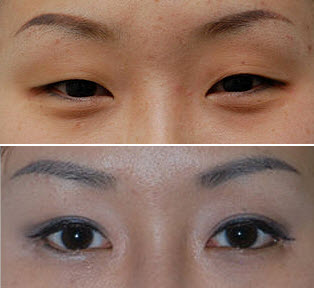Asian Eyelid Surgery

It is important to recognize that there is a high degree of variation in the anatomy of the upper eyelids of Asians. Thus, not only should ethnicity be a factor in blepharoplasty, but also should each individual’s features. A common misconception is that all Asians are born without an upper eyelid crease. In reality, half the Asian population does have a natural crease. For each person, the shape and height of the crease and the relationship of the crease to the facial configuration is a part of the overall assessment before an eyelid procedure is performed. Eyes without a crease are described in the medical literature as having a “single eyelid,” whereas those with two segments of the lids between the eyebrow and the eyelashes have “double eyelids” as typical of most Caucasians.
Dr. Carey prefers to create a central lid crease at its natural position at the top of the eyelid tarsus (or eyelid skeleton). Reformation of the existing crease or creation of a new one (constructing a double eyelid) serves to lift the skin and muscle away from the lid margin and, to a minor degree, lifts the upper lid. This can be combined with a ptosis repair which is a procedure that deals with the deep levator muscle of the eyelid, serving to give a more marked elevation of the upper lid. Ptosis repair is done very cautiously to avoid a “surprised look.”
Another issue of concern to many Asians is the medial canthal fold. Dr. Carey tends to be conservative in the correction of medial upper lid folds for several reasons: First the fold may change with time, especially in younger patients. Second, the skin is thick near the bridge of the nose and is prone to scarring. Finally, a medial tapered crease that merges with the origin of a mild medial upper lid fold provides an aesthetically natural crease as is seen in the Asians that do have a lid crease.
Asian blepharoplasty is a common procedure performed by Dr. Carey. He has operated on upper and lower lids of Asian patients from their 20s to their 90s. He understands the anatomic differences and unique principles applied to the Asian patient.
